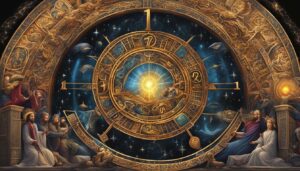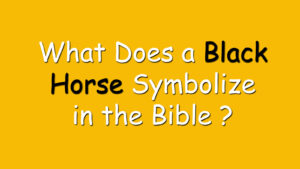As we approach the festive season, many of us will be putting up Christmas trees in our homes, but have you ever wondered about the symbolic meaning of the Christmas tree in the Bible? In this section, we will explore the significance of the Christmas tree in Christian faith and tradition.
In the Bible, trees represent various aspects of life and faith. For example, in the Garden of Eden, the Tree of Life symbolized eternal life and was forbidden to Adam and Eve after they sinned. However, in Revelation, John sees the Tree of Life restored as a symbol of eternal life for those who believe in Christ.
The Christmas tree holds symbolic connections to the Tree of Life and the themes of redemption found in the Bible. In Jeremiah 10:3-4, there is a description of cutting down a tree, adorning it with silver and gold, and fastening it with a hammer so that it will not totter. This passage has been interpreted as a reference to the Christmas tree and its decoration.
Key Takeaways:
- The Christmas tree holds symbolic connections to the Tree of Life and themes of redemption found in the Bible.
- The passage in Jeremiah 10:3-4 has been interpreted as a reference to the Christmas tree and its decoration.
The Tree of Life and Redemption in the Bible
As Christians, we often associate the Christmas tree with themes of redemption and eternal life. This connection stems from the biblical symbolism of the Tree of Life. In the book of Genesis, we read about the Garden of Eden, where God planted two trees: the Tree of Life and the Tree of Knowledge of Good and Evil (Genesis 2:9). Adam and Eve were instructed not to eat from the latter, but were allowed to eat from the Tree of Life (Genesis 2:16-17).
However, after they disobeyed God’s command and ate from the forbidden tree, they were banished from the Garden and prevented from eating from the Tree of Life (Genesis 3:22-23). As a result, they experienced physical death and were separated from God’s presence.
But now that you have been set free from sin and have become slaves of God, the benefit you reap leads to holiness, and the result is eternal life. For the wages of sin is death, but the gift of God is eternal life in Christ Jesus our Lord. – Romans 6:22-23
Despite this separation, God had a plan for redemption. He sent His son Jesus Christ to die on the cross for our sins, so that we may have eternal life and be reconciled to Him (John 3:16). Through faith in Jesus, we can partake in the Tree of Life and experience true spiritual life (Revelation 22:14).
I am the vine; you are the branches. If you remain in me and I in you, you will bear much fruit; apart from me you can do nothing. – John 15:5
In this way, the Christmas tree represents the Tree of Life and the themes of redemption found in the Bible. By placing presents under the tree, we also symbolize the gift of salvation that God has given us through Jesus Christ.
Evergreen Trees as Symbols of Hope and Persistence
As we have already discussed, Christmas trees are often made from evergreen trees, which is not a coincidence. These trees have been regarded as symbols of hope and persistence in Christianity, and there are several biblical verses that support this meaning.
“But the righteous will flourish like a palm tree, they will grow like a cedar of Lebanon; planted in the house of the Lord, they will flourish in the courts of our God. They will still bear fruit in old age, they will stay fresh and green.” – Psalm 92:12-14
This passage compares the righteous to trees that are planted in the house of the Lord, which represents a life of faith. The image of trees bearing fruit in old age and staying fresh and green represents the idea of perseverance and steadfastness in the face of challenges.
“But blessed is the one who trusts in the Lord, whose confidence is in him. They will be like a tree planted by the water that sends out its roots by the stream. It does not fear when heat comes; its leaves are always green. It has no worries in a year of drought and never fails to bear fruit.” – Jeremiah 17:7-8
This passage also compares the faithful to trees, using the image of a tree that is planted by water and has roots that draw from a constant source of nourishment. This symbolizes a life of faith that is rooted in God’s grace, which provides strength and resilience during difficult times. The passage also speaks of trees that do not fear heat or drought, further emphasizing the idea of hope and persistence.
These verses demonstrate the spiritual significance of evergreen trees and their connection to the message of faith and endurance. As we decorate our Christmas trees with lights, ornaments, and other symbolic decorations, we are reminded of the importance of perseverance and the hope that comes from a life of faith.
The Connection between Light and the Christmas Tree
The Christmas tree is not just a beautiful decoration but also a powerful symbol of Christian faith. One of the most significant features of the Christmas tree is the lights that decorate it. These lights hold deep spiritual significance and have a biblical interpretation.
In the Bible, light is often associated with God and His presence. Psalm 27:1 states, “The Lord is my light and my salvation; whom shall I fear? The Lord is the stronghold of my life; of whom shall I be afraid?” This verse emphasizes the power of God’s light in providing safety and security.
“In the same way, let your light shine before others, so that they may see your good works and give glory to your Father in heaven.” – Matthew 5:16
As Christians, we are called to be a reflection of God’s light in the world. Matthew 5:16 says, “In the same way, let your light shine before others, so that they may see your good works and give glory to your Father in heaven.” The lights on the Christmas tree can serve as a reminder of our responsibility to share God’s light with those around us.
Additionally, the lights on the Christmas tree can also represent the light of Christ. John 1:5 says, “The light shines in the darkness, and the darkness has not overcome it.” This verse emphasizes the power of Christ’s light in overcoming the darkness of sin and death.
“Again Jesus spoke to them, saying, ‘I am the light of the world. Whoever follows me will never walk in darkness but will have the light of life.'” – John 8:12
Furthermore, John 8:12 states, “Again Jesus spoke to them, saying, ‘I am the light of the world. Whoever follows me will never walk in darkness but will have the light of life.'” This verse highlights the role of Christ as the ultimate source of light and salvation.
Therefore, the lights on the Christmas tree can serve as a reminder of God’s presence, our responsibility to share His light, and the power of Christ’s light in overcoming darkness.
The Origin and Evolution of the Christmas Tree Tradition
The Christmas tree tradition has a fascinating history, with many theories about its origins. Some scholars suggest that the tree’s evergreen foliage is a symbol of eternal life and was used in pagan winter festivals. Others propose that the tradition began in medieval Germany when trees were decorated with apples and other fruits to symbolize the Garden of Eden.
“Thus says the Lord: Do not learn the ways of the nations or be terrified by signs in the heavens, though the nations are terrified by them. For the customs of the peoples are worthless; they cut a tree out of the forest, and a craftsman shapes it with his chisel. They adorn it with silver and gold; they fasten it with hammer and nails so it will not totter.”
– Jeremiah 10:2-4
Despite these theories, there are no direct references to the Christmas tree in the Bible. However, the use of evergreen trees as symbols of hope and persistence can be found in several passages. For example, Psalm 1:3 states that “he [who delights in the law of the Lord] is like a tree planted by streams of water, which yields its fruit in season and whose leaf does not wither.” This metaphorical imagery highlights the importance of steadfastness and resilience in one’s faith.
The Evolution of the Christmas Tree
The modern Christmas tree as we know it today began to take shape in the 16th century, when Germans started to bring decorated trees into their homes for the holiday season. The tradition grew in popularity over time, spreading throughout Europe and eventually to North America. Today, the Christmas tree is a beloved symbol of the holiday season, with many families continuing the tradition of decorating a tree together every year.
The Christmas tree holds deep spiritual significance for many Christians, representing eternal life, redemption, and the importance of perseverance in one’s faith. Whether you celebrate the tradition or not, it serves as a reminder of the beauty and joy of the holiday season and the importance of staying true to one’s beliefs.
The Christmas Tree and Biblical Teachings on Trees and Nativity Scenes
As we explore the symbolic meaning of the Christmas tree in the Bible, we cannot ignore the various teachings and references to trees and nativity scenes found in scripture. In fact, the Christmas tree tradition can be connected to these passages and their relevance to Christian faith.
“And he shall be like a tree planted by the rivers of water, that bringeth forth his fruit in his season; his leaf also shall not wither; and whatsoever he doeth shall prosper.” – Psalm 1:3
One passage that can be connected to the Christmas tree tradition is Psalm 1:3, which describes a tree planted by the rivers of water that bears fruit in its season and never withers. This imagery of a flourishing tree can represent the promise of eternal life and salvation, which the Christmas tree also symbolizes.
Additionally, the nativity scene itself includes representations of trees and plants, such as the stable where Jesus was born being surrounded by an olive tree and a palm tree. These trees serve as reminders of God’s creation and the humble surroundings in which Jesus was born.
“And the fruit thereof shall be for meat, and the leaf thereof for medicine.” – Ezekiel 47:12
Ezekiel 47:12 also speaks of a tree whose fruit is for food and leaves are for healing. This passage can be connected to the Christmas tree tradition, as we gather around the tree to celebrate the birth of Jesus and find comfort in its symbolism of eternal life and redemption.
Conclusion
The Bible contains various teachings and references to trees and nativity scenes that can be connected to the symbolism of the Christmas tree. From Psalm 1:3’s imagery of a flourishing tree to the trees and plants present at the nativity scene, these passages remind us of God’s creation and the humble beginnings of Jesus. The Christmas tree serves as a powerful symbol of eternal life and redemption, and its connection to biblical teachings only adds to its spiritual significance in Christian faith and tradition.
The Christmas Tree as a Reminder of God’s Creation
As we admire the beauty of the Christmas tree, we are reminded of the magnificence of God’s creation. Trees are mentioned frequently in the Bible as symbols of life, growth, and stability. In Proverbs 3:18, it says, “She is a tree of life to those who take hold of her; those who hold her fast will be blessed.” This passage highlights the connection between the Tree of Life and the Christmas tree, representing eternal life and salvation.
But the Christmas tree can also serve as a reminder of our responsibility as stewards of God’s creation. In Genesis 1:26, God said, “Let us make mankind in our image, in our likeness, so that they may rule over the fish in the sea and the birds in the sky, over the livestock and all the wild animals, and over all the creatures that move along the ground.” As caretakers of the earth, we are called to preserve and protect the environment for future generations.
“The earth is the Lord’s, and everything in it, the world, and all who live in it.” – Psalm 24:1
Decorating the Christmas tree with natural elements, such as pinecones, can also serve as a reminder of the beauty and abundance of nature. By being mindful of our impact on the environment, we can express gratitude for God’s creation and honor our role as caretakers of the earth.
So let us remember the significance of the Christmas tree as a symbol of God’s creation and our responsibility to care for it. As we celebrate the holiday season, may we be inspired to cherish and protect the environment, reflecting the love and gratitude we have for all of God’s creations.
The Symbolic Decorations on the Christmas Tree
As we have discussed, the Christmas tree holds deep symbolic meaning in Christian faith and tradition. It represents the Tree of Life, themes of redemption, hope, persistence, and the light of Christ. But what about the decorations that adorn the tree?
Each decoration has its own spiritual significance and adds to the overall symbolism of the tree. Ornaments, for example, can represent the fruits of the Spirit mentioned in Galatians 5:22-23: love, joy, peace, patience, kindness, goodness, faithfulness, gentleness, and self-control. These virtues are the gifts that Christ brings to us, and we can celebrate them by hanging ornament symbols on our Christmas tree.
“But the fruit of the Spirit is love, joy, peace, patience, kindness, goodness, faithfulness, gentleness, self-control; against such things there is no law.” – Galatians 5:22-23
Tinsel, on the other hand, can represent the glory of God and the radiance of Christ. The shimmering strands can remind us of the star that shone over Bethlehem to guide the magi to the newborn king.
Finally, the tree topper, often in the form of an angel or star, represents the angelic host that appeared to the shepherds to announce the birth of Christ.
These symbolic decorations enhance the meaning of the Christmas tree and serve as a reminder of the gifts of love, joy, peace, and salvation that we receive through Christ.
Conclusion
As we have explored in this article, the Christmas tree holds significant symbolic meaning in Christian faith and tradition. Its origins and associated decorations remind us of God’s creation and the importance of stewardship.
Through the biblical references to trees and nativity scenes, we can see the connection between the Christmas tree and our faith. Just as the Tree of Life represents eternal life and salvation, the Christmas tree can serve as a reminder of God’s grace and love for us.
Furthermore, the use of evergreen trees as symbols of hope and persistence encourages us to have faith and endurance in our daily lives. And the addition of lights to the tree reminds us of the light of Christ, which shines brightly in our lives and in the world.
The Meaning of the Christmas Tree in the Bible
From the biblical symbolism of the Christmas tree to its religious interpretation, we can see how it represents various important aspects of our faith. As we gather around the tree this Christmas season, let us remember the symbolism it holds and reflect on the messages of hope, faith, and love that it brings.
As the prophet Isaiah wrote, “The people walking in darkness have seen a great light; on those living in the land of deep darkness a light has dawned” (Isaiah 9:2, NIV). Let us embrace the light of Christ and the symbolism of the Christmas tree, and let it guide us as we journey through life.
FAQ
Q: What does the Christmas tree symbolize in the Bible?
A: The Christmas tree holds deep symbolic meaning in Christian faith and tradition. It represents the Tree of Life, redemption, hope, and the light of Christ.
Q: How does the Christmas tree connect to the Tree of Life and redemption in the Bible?
A: The Christmas tree holds symbolic connections to the Tree of Life and the themes of redemption found in the Bible. It represents eternal life and salvation.
Q: What is the significance of evergreen trees in Christianity?
A: Evergreen trees, used as Christmas trees, are symbols of hope and persistence in Christianity. They correlate to the message of faith and endurance.
Q: What is the religious interpretation of the Christmas tree?
A: The Christmas tree, adorned with lights, holds religious significance in relation to Christian faith. It represents the light of Christ.
Q: What are the possible biblical origins of the Christmas tree tradition?
A: The Christmas tree tradition has historical roots and has evolved over time. Its possible biblical origins will be discussed in this section.
Q: Are there any biblical teachings and references related to the Christmas tree?
A: The Bible contains teachings and references to trees and nativity scenes that can be connected to the symbolism of the Christmas tree.
Q: How does the Christmas tree serve as a reminder of God’s creation?
A: The Christmas tree can serve as a reminder of God’s creation and the importance of caring for the environment, aligning with biblical teachings on stewardship.
Q: What is the spiritual significance of the decorations on the Christmas tree?
A: The decorations on the Christmas tree, such as ornaments and tinsel, hold spiritual meanings in Christian faith. They contribute to the overall symbolism of the Christmas tree.
Q: What does the Christmas tree symbolize in Christian faith and tradition?
A: The Christmas tree symbolizes various aspects of Christian faith, including the Tree of Life, redemption, hope, persistence, the light of Christ, and God’s creation. Its associated decorations further contribute to its symbolism.




